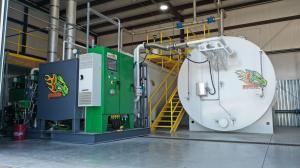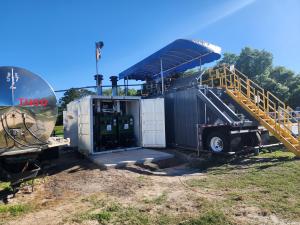FOG And Fatbergs: Food for a Growing Army of Green Monsters
At last, a sustainable way to address the never-ending stream threatening the health of communities and the wastewater treatment plants that serve them.
LANSING, WEST VIRGINIA, USA, April 11, 2024 /EINPresswire.com/ -- Back in 1972 at the movies, a never-ending supply of pollution fed a malevolent, fictional Smog Monster, which threatened humanity until a certain humongous, green lizard put an end to the threat. These days, there’s a different—but very real—type of never-ending stream threatening the health of cities, suburbs, rural America, and the wastewater treatment plants that serve them.
This threat is the endless stream of fats, oils and grease (FOG1) that fill our nation’s system sewer systems. A byproduct of many processes, but primarily the manufacture of animal products and the preparation of food in both commercial and residential kitchens, FOG enters the sewer system through overflowing or malfunctioning grease traps from restaurants, food processing locations, and—yes—even residential kitchen sinks.
For most folks, FOG is “out of sight, out of mind,” once it goes down the drain; but in the end, residents end up paying for the problems it causes. Municipalities often have to raise water bills to deal with the costly impact of FOG.
Once it enters the regular wastewater stream, FOG cools and congeals and thickens. This congealed oil skids along wastewater pipelines, leaving greasy deposits that can attract other grease, dirt, and debris. This effectively reduces the pipes’ diameters, along with the volume of water they can move. This reduces the efficiency of the entire system. The rest of the chunks usually get stuck in a bend or at an exit in the pipes and build in size to what are now called “fatbergs” by those who work in the wastewater management industry.
But worst of all, much of the FOG ends up in wastewater treatment plants, where it clogs up filters, screens and other vital, expensive equipment. This kills plant efficiency by requiring constant cleaning that shuts down parts of the plant, eventually forcing plants to have to expand just to keep up. This expense is burdensome to municipalities and the taxpayers they serve.
Happily, there is a new green lizard that feeds on this FOG stream, transforming it from this huge problem into a sustainable source of clean, renewable biofuel. Greasezilla® is a powerful hydronic-thermal FOG separation system that can be installed in as little as 1,000-2,000 sq. ft. It ecologically processes FOG into three separate components: 80-85% of it ends up as pasteurized water, which is clean enough to re-enter the waste stream; 5-15% becomes Brown Grease Advanced Biofuel (ABF); and the remainder becomes a batter-like substance that feeds anaerobic digesters and composters in treatment plants.
Greasezilla is a modular pretreatment system, scalable to accommodate any volume, making it an ideal onsite FOG receiving station2 for municipalities whose wastewater treatment plants are at or reaching capacity for FOG processing. Greasezilla is amazingly efficient, with a standard two-reactor tank system processing 6-7 million gallons of FOG waste annually.
It runs on the brown grease biofuel3 it creates, so it’s largely self-sustaining, energy-wise. Unlike traditional processes, Greasezilla fully recovers the energy resources of the waste stream, leaving nominal waste to be landfilled, and requiring no chemicals or additives. This makes Greasezilla ABF the “Roundest Fuel,” most fully embodying the tenets of a completely closed/no waste reuse cycle.
The convergence of waste reduction initiatives, low-carbon biofuel demand, tightening emissions regulations, and environmental sustainability goals have created unprecedented demand for renewable fuel feedstocks. This demand will only continue to grow, requiring more feedstock supply for environmentally friendly fuel.
Greasezilla produces this feedstock, turning a former waste material from something that clogs landfills and produces methane into a clean, saleable, renewable resource that will help support healthy wastewater treatment plants. In this way, Greasezilla is very much a part of the solution when it comes to actively creating a more sustainable energy future for our planet.
With this new technology, FOG can now realistically be turned from a crippling fiscal and physical problem for communities, to a new revenue stream that will keep taxes down by using existing capacity more efficiently and delaying the need for costly plant expansions; greatly decrease costs for FOG cleanup and processing; keep FOG out of landfills; and contribute to readily usable renewable resources.
# # #
Download High Resolution Image Files Here: https://drive.google.com/drive/folders/1YST0XNL475_RpgOIv89voSdAcXgMY-2F?usp=drive_link
About Greasezilla:
Greasezilla provides services and technology that significantly reduce or eliminate costs associated with dewatering, drying, lagooning, land applying, composting, incinerating, hauling, tipping or any further treatment of wastewater and grease trap output. In the process, Greasezilla creates a biofuel feedstock sold on commodity exchanges for competitive rates. For more information, visit Greaszilla.com.
Brian Levine
Greasezilla
+1 304-658-4778
info@greasezilla.com
Visit us on social media:
Facebook
Twitter
LinkedIn
Other
WATCH NOW: An Introduction to FOG and the Greasezilla Solution at https://vimeo.com/740470722
1 https://greasezilla.com/fog-101/
2 https://greasezilla.com/wastewater-treatment-fog-receiving-station/
3 https://greasezilla.com/biofuels-biodiesel/



